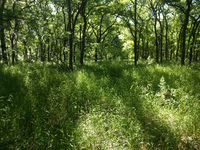Pseudomonas putida alesha & gwen
Classification
Domain; Phylum; Class; Order; family [Others may be used. Use NCBI link to find]
Domain: Bacteria
Phylum: Proteobacteria
Class: Gammaproteobacteria
Order: Pseudomonadales
Family: Pseudomonadaceae
Genus: Pseudomonas
Species
Pseudomonas putida
|
NCBI: Taxonomy |
Habitat Information
Describe the location and conditions under which the organism was isolated.
The organism Pseudomonas putida was collected and isolated from a 3 Tbsp soil sample gathered at the Dove Springs District Park at 5801 Ainez Drive in Austin, Texas, at a location with the coordinates of Latitude: 30.184271 and Longitude: -97.736561. The collection point lay within a wooded area between the baseball field and Williamson Creek, located approximately 50 to 60 feet West of the creek and approximately 30 feet Southeast of the nearest walking trail.
The soil sample collection occurred on January 28, 2016. The temperature was 61°F with 39% humidity, no rainfall in the prior 24 hours, and solar radiation of 17.35 MJm2. Soil was collected from the surface to a depth of 1 inch. The collection location is fully shaded in summer and partly shaded in winter with low foot traffic.
According to the USDA Natural Resources Conservation Service Web Soil Survey, the soil in the location of collection consists of Oakalla silty clay loam, with 0-2% slopes, and is frequently flooded.
Description and Significance
Describe the appearance (colonial and cellular), possible antimicrobial activity etc. of the organism, and why the organism might be significant.
Upon isolation and growth on an LB agar plate P. putida colonies appear mostly translucent and colorless. They are umbonate in shape and round with smooth, entire margins. Colonies appear shiny but not mucoid.
Under microscopic observation after performing a Gram stain, the cellular arrangement of P. putida appears to be single rods.
While none of the organisms isolated from the collected soil samples showed evidence of any kind of clearing around the colony when grown on a lawn of S. aureus or E. coli, including P. putida, this particular organism was selected due to the difference in colony morphology it exhibited when grown on a lawn of S. aureus. Isolated colonies of P. putida appear as described above. However, when grown in the presence of S. aureus, the colony of P. putida appeared dark brown in color, with a flat shape and irregular border. Although this did not suggest antimicrobial activity, it was the only isolated organism that exhibited a change in growth in the presence of another bacteria.
Genome Structure
[1] According to the Pseudomonas Genome Database the size of Pseudomonas putida KT2440 genome is 6,181,863 nucleotide pairs. Of that, there is a 61.5% guanine and cytosine pairing and the other 38.5% is adenine and thymine. P. putida has a single circular chromosome. P. putida was found to share many homologous ORF's (4610/5420) with bacterium Pseudomonas aeruginosa. It is the first gram negative bacteria certified as a biosafety host for cloning of foreign genes [2]. Include S Ribosomal sequence that you obtained from PCR and sequencing here.
Gwen
Cell Structure, Metabolism and Life Cylce
Pseudomonas putida is a aerobic, gram negative, rod shaped bacteria. It is nonsporeforming and is motile by one or more flagella. This organism grew well on the TSA agar, LB broth and LB agar but was otherwise slow to grow in other mediums used in lab.
Although no tests were performed to prove a terminal electron acceptor, "P. putida" does reduce nitrate to nitrite; gaining an electron in the process.
Physiology and Pathogenesis
Biochemical characteristics, enzymes made, other characteristics that may be used to identify the organism; contributions to environment (if any).
If relevant, how does this organism cause disease? Human, animal, plant hosts? Virulence factors, as well as patient symptoms.
Alesha http://journals.plos.org/plosgenetics/article?id=10.1371/journal.pgen.0020007
References
[1] Winsor GL, Griffiths EJ, Lo R, Dhillon BK, Shay JA, Brinkman FS (2016). Pseudomonas Genome DB. The Brinkman Lab at Simon Fraser University. n.d. Web. 20 April 2016. <http://www.pseudomonas.com/strain/show/110>
[2] Nelson KE, Weinel C, Paulsen IT, Dodson RJ, Hilbert H, et al. (2002) Complete genome sequence and comparative analysis of the metabolically versatile Pseudomonas putida KT2440. Environ Microbiol 4: 799–808.
Author
Page authored by Alesha Larkins and Gwen Schurmann, student of Prof. Kristine Hollingsworth at Austin Community College.


